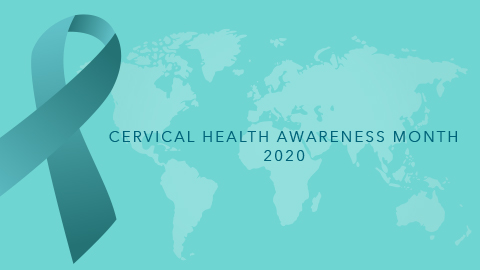Cervical Health Awareness Month
Cervical cancer is the most preventable cancer in women, yet more than 300,000 women worldwide lost their lives to it in 2018, according to the World Health Organization. Today, on account of Cervical Cancer Awareness Month, I present to you some facts about cervical cancer and highlights of recent research on it.
What is cervical cancer?
It is a cancer of the cells of the cervix — the lower part of the uterus connecting the vagina. The most common type of cervical cancer is squamous cell carcinoma, which originates from the cells lining the ectocervix (part of the cervix extending outward to the vagina) and accounts for about 80% of cervical cancers, according to the American Cancer Society.

What causes cervical cancer?
The majority of cervical cancer cases are caused by human papillomavirus, or HPV, infection. There are more than 100 types of HPV, of which 14 are known to cause cancer, according to the WHO. Specifically, HPV types 16 and 18 are responsible for 70% of cervical cancers and precancerous lesions.
HPV is a sexually transmitted virus that spreads through skin-to-skin contact and can lead to cervical cancer even decades after being first transmitted. In addition to cervical cancer, HPV infection is also linked to cancers in the vulva, vagina, anus and penis. HPV also causes cancer in the mouth and throat through oral sex. It is important to know that the risk for cervical cancer by HPV infection also exists for individuals with a single sexual partner.
According to American Cancer Society, cervical cancer diagnosis is highly common in women between the ages 35 and 44, and it is highly uncommon in women under 20 years of age.
The CDC reports that the risk for HPV-associated cervical cancer is higher in Hispanic and Black women, possibly due lack of access to screening or treatment.
How to prevent cervical cancer
Cervical cancer can be prevented by getting vaccinated against HPV. The CDC suggests that the HPV vaccination is most effective in females aged 11 to 26. Girls around 11 or 12 require two doses of the vaccine at least six months apart. Teens and young adults who start the vaccination series before 26 require three doses for effective protection.
Since cervical cancer does not show any symptoms in the early stages, the CDC recommends that women aged 21 through 65 get screened for precancerous lesions by having a Papanicolaou (Pap) smear every three years. During a Pap smear, a gynecologist, physician or nurse practitioner collects cells from the cervix that are then sent to a laboratory, where a pathologist examines them for any precancerous or cancerous lesions. The risk for cervical cancer is greatly reduced in women who undergo regular screenings because of the increased chance at early diagnosis.
What is the treatment for cervical cancer?
The most common treatment strategies for cervical cancer include surgery, chemotherapy and radiation. Surgery can include killing cancerous tissue with a laser or cutting it out. Radiation therapy uses high-energy X-rays to kill cancer cells, and it may be a part of the main treatment regimen or used for cancer that has returned or spread to different organs. Chemotherapy involves the administration of anticancer drugs orally or into the vein of the patients. The gynecologic oncologist may also enroll patients in clinical trials for novel therapies, but these are less common than the other methods of treatment.
What does recent research on cervical cancer tell us?
Below is a collection of some cervical cancer research articles published in American Society for Biochemistry and Molecular Biology journals.
Uncovering the factors involved in the survival of cancer cells: Cervical cancer patients often develop resistance to chemotherapy, which leads to cancer recurrence and even death. The protein PACS-1 is a sorting protein involved in transporting cargo from Golgi complexes to different cell organelles. It is abundantly expressed in cervical cancer cells compared with healthy cells. A recent article in the Journal of Biological Chemistry showed that PACS-1 expression is controlled by micro-RNAs, hsa-miR-34a and hsa-miR-449a. MicroRNAs are small noncoding RNAs that regulate gene expression in mammalian cells. This study suggests that absence of expression of these two miRNAs leads to PACS-1 overexpression, resulting in the development of chemotherapy-resistant tumors.
Understanding the spread of cancer cells: Cancer cells are capable of detaching from a surface and spreading to distant organs. This process is known as metastasis, and it requires the cells to grow without attachment to a surface (anchorage-independent growth). This publication in JBC revealed a novel mechanism of activation of Akt signaling cascade responsible for anchorage-independent growth . Cool-associated tyrosine-phosphorylated protein 1, or Cat-1, interacts with binding partner paxillin to activate Akt signaling, promoting anchorage-independent growth. This study advances our understanding of how cervical cancer spreads.
Identifying biomarkers in the blood to detect cervical cancer: Diagnosis of cervical cancer currently relies on Pap smear to test for precancerous lesions in women who have tested positive for HPV infection. But scientists are on a quest for more accurate and reliable biomarkers. A recent report published in the journal Molecular & Cellular Proteomics revealed a panel of 11 biomarkers in the plasma of patients with invasive cervical cancer. This biomarker signature could improve diagnosis and provide a reliable and noninvasive screening method.
Enzymes in cervical cancer signaling: 1-acylglycerol3-phosphate-O-acyltransferase isoform 11, or AGPAT11 for short, is an enzyme involved in the production of phosphatidic acid, or PA, in cells. PA is a signaling molecule that activates cascades that promote survival and anchorage-independent growth of cancer cells. Scientists identified that AGPAT11 is highly active in patients with advanced cervical cancer, suggesting that it may be a biomarker for the severity of cancer. Read the study in the Journal of Lipid Research.
Enjoy reading ASBMB Today?
Become a member to receive the print edition four times a year and the digital edition monthly.
Learn moreGet the latest from ASBMB Today
Enter your email address, and we’ll send you a weekly email with recent articles, interviews and more.
Latest in Science
Science highlights or most popular articles

Building the blueprint to block HIV
Wesley Sundquist will present his work on the HIV capsid and revolutionary drug, Lenacapavir, at the ASBMB Annual Meeting, March 7–10, in Maryland.

Gut microbes hijack cancer pathway in high-fat diets
Researchers at the Feinstein Institutes for Medical Research found that a high-fat diet increases ammonia-producing bacteria in the gut microbiome of mice, which in turn disrupts TGF-β signaling and promotes colorectal cancer.

Mapping fentanyl’s cellular footprint
Using a new imaging method, researchers at State University of New York at Buffalo traced fentanyl’s effects inside brain immune cells, revealing how the drug alters lipid droplets, pointing to new paths for addiction diagnostics.

Designing life’s building blocks with AI
Tanja Kortemme, a professor at the University of California, San Francisco, will discuss her research using computational biology to engineer proteins at the 2026 ASBMB Annual Meeting.

Cholesterol as a novel biomarker for Fragile X syndrome
Researchers in Quebec identified lower levels of a brain cholesterol metabolite, 24-hydroxycholesterol, in patients with fragile X syndrome, a finding that could provide a simple blood-based biomarker for understanding and managing the condition.

How lipid metabolism shapes sperm development
Researchers at Hokkaido University identify the enzyme behind a key lipid in sperm development. The findings reveal how seminolipids shape sperm formation and may inform future diagnostics and treatments for male infertility.

